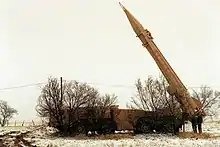| Shahab-2 | |
|---|---|
 | |
| Type | Tactical SRBM |
| Service history | |
| In service | 1990–2016[1] |
| Used by | |
| Production history | |
| Manufacturer | Iran |
| Specifications | |
| Mass | 6,370–6,500 kg |
| Length | 11.37–12.29 m |
| Diameter | 0.885 m |
| Warhead | 770kg[2] |
| Engine | Liquid |
Operational range | 500 km[3] |
Guidance system | inertial |
| Accuracy | 500m CEP[4] |
The Shahab-2 (Persian: شهاب ۲, romanized: Ŝahāb 2, meaning "Meteor-2") is the successor to the Iranian Shahab-1 missile. It is based on the North Korean Hwasong-6 (modified version of the Hwasong-5, itself a modification of the R-17 Elbrus).[5]
On November 2, 2006, Iran fired unarmed missiles to begin 10 days of military simulations. Iranian state television reported "dozens of missiles were fired including Shahab-2 and Shahab-3 missiles. The missiles ranged from 300 km to up to 2,000 km. ... Iranian experts have made some changes to Shahab-3 missiles installing cluster warheads in them with the capacity to carry 1,400 bombs." These launches come after some United States-led military exercises in the Persian Gulf on October 30, 2006, meant to train for blocking the transport of weapons of mass destruction.[6]
Variants
Shahab is the name of a class of Iranian missiles, service time of 1988–present, which comes in six variants: Shahab-1, Shahab-2, Shahab-3, Shahab-4, Shahab-5, Shahab-6.
See also
References
- ↑ تولید موشک شهاب 1 و 2 متوقف شد/ هیچ یک از موفقیتهای ایران با سازش بدست نیامده است Mashregh News
- ↑ "Shahab-2 (Scud C-Variant)".
- ↑ http://www.nasic.af.mil/LinkClick.aspx?fileticket=F2VLcKSmCTE%3d&portalid=19
- ↑ "Shahab-2 – Missile Defense Advocacy Alliance".
- ↑ "Shahab-2".
- ↑ "Iran fires unarmed missiles - CNN.com". www.cnn.com. Archived from the original on 2006-11-02.
External links
- CSIS Missile Threat - Shahab-2
- Shahab-3 / Zelzal-3 (www.fas.org)
- Shahab-2 (www.fas.org)
- A Preemptive Attack on Iran's Nuclear Facilities: Possible Consequences (cns.miis.edu)

